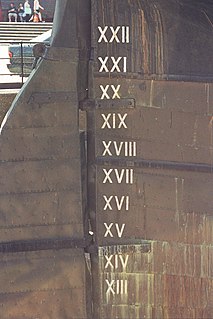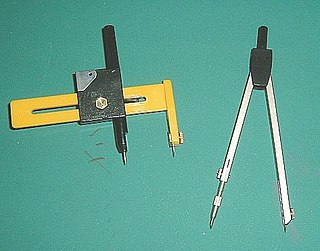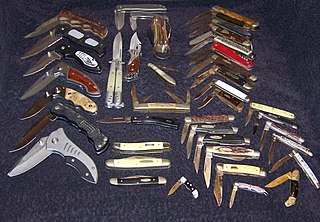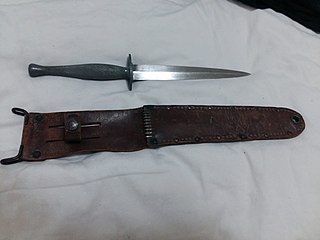
A knife is a tool or weapon with a cutting edge or blade, usually attached to a handle or hilt. One of the earliest tools used by humanity, knives appeared at least 2.5 million years ago, as evidenced by the Oldowan tools. Originally made of wood, bone, and stone, over the centuries, in step with improvements in both metallurgy and manufacturing, knife blades have been made from copper, bronze, iron, steel, ceramic, and titanium. Most modern knives have either fixed or folding blades; blade patterns and styles vary by maker and country of origin.

Roman numerals are a numeral system that originated in ancient Rome and remained the usual way of writing numbers throughout Europe well into the Late Middle Ages. Numbers in this system are represented by combinations of letters from the Latin alphabet. Modern style uses seven symbols, each with a fixed integer value:
Thai numerals are a set of numerals traditionally used in Thailand, although the Arabic numerals are more common due to extensive westernization of Thailand in the modern Rattanakosin period. Thai numerals follow the Hindu–Arabic numeral system commonly used in the rest of the world. In Thai language, numerals often follow the modified noun and precede a measure word, although variations to this pattern occur.

An athame or athamé is a ceremonial blade, generally with a black handle. It is the main ritual implement or magical tool among several used in ceremonial magic traditions, and by other neopagans, witchcraft, as well as satanic traditions. A black-handled knife called an arthame appears in certain versions of the Key of Solomon, a grimoire dating to the Renaissance.
Greek numerals, also known as Ionic, Ionian, Milesian, or Alexandrian numerals, are a system of writing numbers using the letters of the Greek alphabet. In modern Greece, they are still used for ordinal numbers and in contexts similar to those in which Roman numerals are still used in the Western world. For ordinary cardinal numbers, however, modern Greece uses Arabic numerals.

A compass, more accurately known as a pair of compasses, is a technical drawing instrument that can be used for inscribing circles or arcs. As dividers, it can also be used as a tool to mark out distances, in particular, on maps. Compasses can be used for mathematics, drafting, navigation and other purposes.

A clock face is the part of an analog clock that displays time through the use of a flat dial with reference marks, and revolving pointers turning on concentric shafts at the center, called hands. In its most basic, globally recognized form, the periphery of the dial is numbered 1 through 12 indicating the hours in a 12-hour cycle, and a short hour hand makes two revolutions in a day. A long minute hand makes one revolution every hour. The face may also include a second hand, which makes one revolution per minute. The term is less commonly used for the time display on digital clocks and watches.

Timber framing and "post-and-beam" construction are traditional methods of building with heavy timbers, creating structures using squared-off and carefully fitted and joined timbers with joints secured by large wooden pegs. If the structural frame of load-bearing timber is left exposed on the exterior of the building it may be referred to as half-timbered, and in many cases the infill between timbers will be used for decorative effect. The country most known for this kind of architecture is Germany, where timber-framed houses are spread all over the country.

In archaeology, timber circles are rings of upright wooden posts, built mainly by ancient peoples in the British Isles and North America. They survive only as gapped rings of post-holes, with no evidence they formed walls, making them distinct from palisades. Like stone circles, it is believed their purpose was ritual, ceremonial, and/or astronomical.

A pocketknife is a knife with one or more blades that fold into the handle. They are also known as jackknives (jack-knife), folding knives, or may be referred to as a penknife, though a penknife may also be a specific kind of pocketknife. A typical blade length is 5 to 15 centimetres.
Marking out or layout means the process of transferring a design or pattern to a workpiece, as the first step in the manufacturing process. It is performed in many industries or hobbies although in the repetition industries the machine's initial setup is designed to remove the need to mark out every individual piece.

Japanese carpentry was developed more than a millennium ago through Chinese architectural influences from the 12th century. It is a form of ancient Chinese wooden architecture and woodworking joints that involves building wooden furniture without the use of nails, screws, glue, or electric tools.

A billhook or bill hook, also called a pruning knife or spar hook, is a versatile cutting tool used widely in agriculture and forestry for cutting woody material such as shrubs, small trees and branches. It is distinct from the sickle. It was commonly used in Europe with an important variety of traditional local patterns. Elsewhere, it was also developed locally such as in the Indian subcontinent, or introduced regionally as in the Americas, South Africa and Oceania by European settlers.

A combat knife is a fighting knife designed solely for military use and primarily intended for hand-to-hand or close combat fighting.
The Gerber Mark II is a fighting knife manufactured by Gerber Legendary Blades from 1966 to 2000, with an additional limited run of 1500 in 2002, and full production resuming as of July 2008. It was designed by retired United States Army Captain, Bud Holzman, who based the pattern on a Roman Mainz Gladius.

The Fairbairn–Sykes fighting knife is a double-edged fighting knife resembling a dagger or poignard with a foil grip. It was developed by William Ewart Fairbairn and Eric Anthony Sykes in Shanghai based on ideas that the two men had while serving on the Shanghai Municipal Police in China before World War II.

The Hindu–Arabic numeral system or Indo-Arabic numeral system is a positional decimal numeral system, and is the most common system for the symbolic representation of numbers in the world.
This glossary of woodworking lists a number of specialized terms and concepts used in woodworking, carpentry, and related disciplines.

The United States Marine Raider stiletto was issued to the Marine Raiders and 1st Canadian Parachute Battalion during World War II.
















